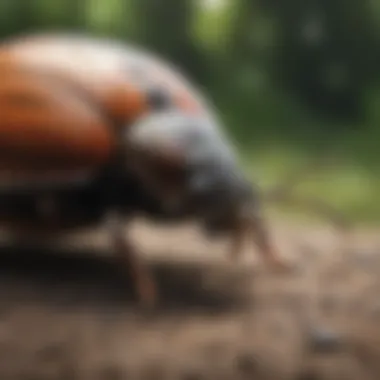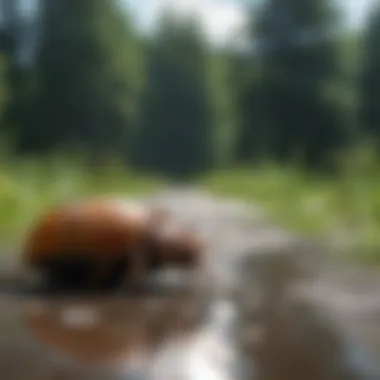Effective Strategies to Eliminate May Beetles from Your Property - A Comprehensive Guide


Animal Species Profile
May beetles, also known as June bugs or June Beetles, are common beetles belonging to the genus Phyllophaga in the family Scarabaeidae. These beetles are characterized by their stout bodies, typically measuring around one inch in length, and their distinct shiny exoskeletons that range in color from brown to reddish-brown. May beetles are commonly found across North America and Europe, inhabiting grassy areas, gardens, and agricultural lands.
May beetles are nocturnal creatures, emerging at night to feed on plant matter like leaves, fruits, and flowers. They are known to be attracted to artificial lights, often swarming around outdoor light sources in the evening. During the day, these beetles burrow into the soil to lay eggs, completing their life cycle underground as larvae before emerging as adults.
Experiencing an infestation of May beetles can be quite frustrating, as their feeding habits can damage plants and vegetation on your property. To effectively eradicate these pests, several strategies can be implemented. One natural remedy involves creating barriers around plants using physical barriers, such as row covers or screens, to prevent adult beetles from feeding on them. Additionally, introducing beneficial nematodes to the soil can help target and eliminate May beetle larvae, reducing their population over time. For a more immediate solution, seeking professional pest control services can offer targeted treatments to eradicate May beetles effectively.
When combating a May beetle infestation, it is crucial to consider the implications of using chemical pesticides on the environment and other beneficial insects. Therefore, opting for environmentally friendly pest control methods is a sustainable approach to solving the issue without harming the ecosystem. Integrated pest management techniques, such as crop rotation and biological controls, can also be employed to regulate May beetle populations and minimize damage to plants.
Understanding May Beetles:
May beetles pose a significant threat to your property and need to be eradicated effectively. In this comprehensive guide, we delve into the reasons why understanding May beetles is crucial. By studying their behavior, lifecycle, and habitat, we can develop targeted strategies for eradication.
Identification of May Beetles:
Physical Characteristics:
May beetles exhibit specific physical characteristics that aid in their identification and control. Understanding these features, such as their size, color, and elytra texture, is vital for implementing effective pest management techniques. Their ability to fly and nocturnal nature also play a key role in their lifecycle.
Life Cycle:
Exploring the life cycle of May beetles sheds light on their vulnerabilities. From egg to larva to adult, each stage presents opportunities for intervention. By disrupting their breeding cycle, we can curb infestations and prevent future generations from plaguing your property.
Habitat:
May beetles thrive in specific environments, often preferring lawns, gardens, and agricultural fields. Learning about their habitat preferences allows us to target these areas with precision. By minimizing conducive habitats and making them inhospitable, we can deter May beetles effectively.
Behavioral Patterns:
Feeding Habits:
Understanding May beetles' feeding habits is essential for devising control strategies. Whether they feed on plant roots or foliage, their dietary preferences dictate which plants are at risk. Implementing measures to protect vulnerable vegetation is key to mitigating damage caused by these voracious pests.
Mating Behavior:
May beetles' mating behavior influences their population dynamics. By disrupting mating patterns through pheromone traps or other methods, we can reduce their numbers significantly. Studying their courtship rituals and reproductive processes provides insight into effective population control.


Movement Patterns:
May beetles exhibit distinctive movement patterns that aid in their dispersal. Understanding how they travel from one location to another helps in predicting infestation spread. By blocking their typical movement pathways or creating barriers, we can limit their access to new areas, aiding in containment and control.
Preventive Measures
Preventive measures play a significant role in eradicating may beetles from your property. By focusing on environmental modifications, natural deterrents, and physical barriers, you can effectively control these pests. Environmental modifications involve reducing outdoor lighting, managing lawn care practices, and preventing excessive moisture in your surroundings. Reducing outdoor lighting helps deter may beetles as they are attracted to light sources. Managing lawn care practices such as regular mowing and aeration creates an inhospitable environment for May beetles, decreasing their presence on your property. Preventing excessive moisture reduces the likelihood of may beetle infestations, as they thrive in damp conditions.
Environmental Modifications
Reducing Outdoor Lighting
The strategy of reducing outdoor lighting is crucial in preventing may beetles from invading your property. May beetles are nocturnal insects attracted to sources of light. By minimizing outdoor lighting, you can discourage these pests from congregating around your home. This method is highly effective in reducing the presence of may beetles and other nocturnal insects that pose a threat to your property.
Managing Lawn Care Practices
Effective lawn care practices contribute significantly to mitigating may beetle infestations. Keeping your lawn well-maintained by regular mowing, aerating, and fertilizing creates an environment that is less appealing to may beetles. A healthy and well-groomed lawn provides fewer hiding spots and less food for these pests, reducing their population around your property.
Preventing Excessive Moisture
Preventing excess moisture is key to preventing may beetle infestations. May beetles are attracted to damp environments, making it essential to address any areas of standing water or excessive moisture. By ensuring proper drainage, fixing leaks, and using proper irrigation techniques, you can effectively reduce the risk of may beetle infestations on your property.
Natural Deterrents
Planting Beetle-Repellent Plants
Introducing beetle-repellent plants to your landscape is an effective natural deterrent against may beetles. Certain plants, like marigolds, lavender, and chrysanthemums, have natural properties that repel insects. By strategically planting these flowers around your property, you can create a natural barrier that deters may beetles and other pests. This eco-friendly approach not only beautifies your surroundings but also helps to keep unwanted insects at bay.
Home Remedies and DIY Solutions
In the realm of pest control, Home Remedies and DIY Solutions play a paramount role in addressing pest infestations naturally and effectively. These solutions offer various benefits, like eco-friendliness, cost-effectiveness, and reduced chemical exposure. By utilizing household items and natural ingredients, homeowners can create potent remedies to combat May beetles without harming the environment. Furthermore, these DIY solutions empower individuals to take control of their pest management, fostering a sense of independence and environmental stewardship in the process.
Essential Oils Blend Spray
Recipe and Application
Essential Oils Blend Spray stands out as a popular choice for pest control due to its natural composition and effectiveness against May beetles. The key characteristic of this spray lies in its ability to repel beetles without the use of harsh chemicals, making it a safe and environmentally friendly option. The unique feature of Essential Oils Blend Spray is its pleasant aroma, which not only deters pests but also refreshes indoor spaces. While its advantages include efficacy and non-toxicity, its main disadvantage may be the need for frequent reapplication to maintain effectiveness.
Effectiveness and Safety Precautions


The effectiveness of Essential Oils Blend Spray lies in its ability to repel May beetles while ensuring the safety of pets, humans, and beneficial insects. By using essential oils known for their insect-repelling properties, this spray serves as a potent deterrent against pests without posing health risks. However, it is essential to dilute the oils properly to prevent skin irritation and allergies, emphasizing the importance of following safety precautions during preparation and application.
Frequency of Application
The Frequency of Application for Essential Oils Blend Spray depends on factors like weather conditions, beetle activity, and the concentration of essential oils used. To maintain its efficacy, reapply the spray every few days or after rainfall, as exposure to elements can reduce its longevity. While frequent application ensures continuous protection against May beetles, it requires consistent monitoring to prevent reinfestation and ensure optimal results.
Homemade Traps
Creating an Effective Trap
Creating an Effective Trap is a strategic approach to capturing May beetles without using harmful chemicals. By constructing traps using common household items like jars, lights, and attractants, homeowners can effectively lure and capture beetles. The key characteristic of this method is its simplicity and cost-effectiveness, offering a practical solution for managing beetle populations. However, the main disadvantage lies in the potential for attracting other beneficial insects, requiring precautions to minimize unintended captures.
Placement and Monitoring
Proper Placement and Monitoring of homemade traps are crucial for optimizing their effectiveness against May beetles. Strategic placement near light sources or affected areas enhances trap visibility and beetle attraction, increasing capture rates. Continuous monitoring allows homeowners to assess trap efficiency, identify beetle hotspots, and make adjustments as needed. While this method requires regular inspection and maintenance, its non-toxic nature and targeted approach make it a preferred choice for eco-conscious individuals seeking alternative pest control solutions.
Disposal of Caught Beetles
After successfully trapping May beetles, proper Disposal of Caught Beetles is essential to prevent reinfestation and maintain hygienic conditions. To dispose of trapped beetles, carefully remove the container, seal it securely, and discard it away from the property to prevent accidental releases. Avoid crushing the beetles to prevent attracting more pests and ensure a clean and efficient disposal process. While this method entails handling captured insects, proper disposal practices help in mitigating pest populations and safeguarding the environment.
Professional Pest Control Options
When dealing with a may beetle infestation, considering professional pest control options becomes crucial in effectively managing the situation. Professional extermination services offer the expertise and resources necessary to tackle the issue comprehensively, ensuring a successful outcome. This section delves into the significance of opting for professional assistance, highlighting the specific elements that make this choice beneficial.
Seeking Professional Extermination Services
Choosing Reputable Pest Control Companies
In the realm of pest control, selecting reputable companies is paramount to the success of eradication efforts. These companies boast expertise, experience, and a proven track record in handling various pest infestations effectively, including may beetles. Their commitment to quality service and customer satisfaction sets them apart as the preferred choice for addressing pest issues. By choosing reputable pest control companies, individuals can benefit from professionally executed extermination methods that guarantee lasting results, making it a popular and reliable option for those seeking efficient solutions.
Treatment Options Available
Exploring the diverse array of treatment options available through professional pest control services offers a tailored approach to may beetle elimination. These treatments are specifically designed to target the pest problem at its roots, addressing infestations effectively and ensuring long-term prevention. The availability of multiple treatment options allows for flexibility in selecting the most suitable method based on the extent of infestation and environmental considerations. Professional treatment options provide a comprehensive solution to may beetle issues, reinforcing the effectiveness of seeking expert help.
Cost Considerations
While professional pest control services offer unmatched expertise and tailored solutions, considering the cost implications is essential in making informed decisions. The cost considerations associated with hiring professional extermination services include factors such as the extent of infestation, the chosen treatment method, and any additional services required. While the upfront cost may vary based on these factors, the long-term benefits of professional pest control, including thorough eradication and prevention of reinfestation, outweigh the initial investment. Evaluating the cost-effectiveness of professional services ensures a strategic approach to may beetle eradication, balancing quality with affordability for optimal results.
Integrated Pest Management (IPM)


Integrated Pest Management (IPM) presents a holistic approach to pest control that aligns with sustainable and eco-friendly practices. By incorporating IPM principles into may beetle management strategies, individuals can effectively reduce pest populations while minimizing environmental impact. This section explores the key components of IPM and its benefits in promoting a harmonious balance between pest control and environmental preservation.
IPM Principles
At the core of IPM lies a set of principles that focus on prevention, monitoring, and control of pests through environmentally sensitive practices. These principles emphasize the importance of identifying pest thresholds, implementing preventive measures, and utilizing natural predators to control pest populations. By adhering to IPM principles, individuals can address may beetle infestations with precision and minimal ecological disruption, making it a preferred choice for those prioritizing sustainability in pest management.
Benefits of IPM
The benefits of adopting an IPM approach in may beetle control extend beyond immediate pest eradication to long-term environmental conservation. By reducing reliance on chemical intervention and fostering natural predator-prey relationships, IPM promotes biodiversity and ecological resilience. Individuals implementing IPM strategies experience a significant reduction in pesticide usage, leading to lesser environmental contamination and preserving beneficial insect populations. The holistic benefits of IPM in may beetle management underscore its effectiveness in creating sustainable solutions for pest control challenges.
Implementing IPM Strategies
Integrating IPM strategies into may beetle management involves meticulous planning and execution to achieve desired outcomes. By implementing a combination of preventive measures, biological controls, and habitat modifications, individuals can create an ecosystem that discourages may beetle infestations naturally. The unique feature of IPM lies in its adaptive and localized approach, tailoring pest control strategies to specific environmental conditions and pest behavior. Implementing IPM strategies requires careful consideration of ecological dynamics and pest life cycles, ensuring that pest management aligns with sustainable practices and long-term efficacy.
Long-Term Prevention and Monitoring
In the realm of effectively managing may beetles on your property, the focus shifts towards a sustained approach for long-term prevention and vigilant monitoring. It is imperative to recognize the importance of continuous monitoring and preventing future infestations to uphold a healthy environment. By incorporating long-term prevention and monitoring strategies, property owners can significantly reduce the presence of may beetles and maintain a pest-free landscape.
Regular Property Inspections
Surveillance Techniques
Surveillance techniques play a pivotal role in the overarching strategy of long-term prevention and monitoring against may beetles. By employing various surveillance methods such as night-time observations, trap monitoring, and population density assessments, property owners can gather essential data to track beetle activity and population dynamics. The systematic use of surveillance techniques allows for early detection of potential infestation hotspots, aiding in informed decision-making for pest control measures.
Identifying Early Signs of Infestation
Identifying early signs of may beetle infestation is crucial in mitigating widespread damage to vegetation and landscape. Property owners can learn to recognize indicators like defoliation patterns, larval presence, and adult beetle sightings to promptly address infestation risks. Early intervention based on identifying these signs can prevent exponential population growth and minimize the impact on the ecosystem.
Maintaining Vigilance
Maintaining vigilance is the cornerstone of successful long-term prevention and monitoring strategies. Property owners must remain observant and proactive in regularly inspecting their property for any signs of may beetle activity. Continuous vigilance allows for swift responses to any emerging infestation threats, enabling efficient pest control interventions before the situation escalates. Regular monitoring and active engagement are key components in the battle against may beetles.
Sustainable Practices
Promoting Biodiversity
Promoting biodiversity within the ecosystem can serve as a natural defense mechanism against may beetle infestations. By cultivating a diverse range of plant species, property owners create a robust environment that supports natural predators of may beetles, such as birds and beneficial insects. The ecological balance achieved through biodiversity assists in keeping may beetle populations in check without resorting to chemical interventions, fostering a sustainable and harmonious ecosystem.
Implementing Eco-Friendly Solutions
Implementing eco-friendly solutions aligns with the overarching goal of sustainable pest management. By opting for non-toxic pest control methods, such as pheromone traps and biological insecticides, property owners can effectively combat may beetle infestations while minimizing environmental impact. The adoption of eco-friendly solutions reflects a commitment to maintaining a balanced ecosystem that prioritizes both pest control efficacy and ecological preservation.
Creating Balanced Ecosystems
Creating a balanced ecosystem entails designing a landscape that synergizes with natural processes to deter may beetle infestations organically. Property owners can establish native plant habitats, conserve natural predators, and limit chemical pesticide use to foster a self-regulating ecosystem. By promoting a harmonious balance between flora and fauna, property owners contribute to the long-term resilience of their ecosystem against may beetle disturbances.







